

 Freemasonry in Israel
Freemasonry in Israel


 Freemasonry in Israel
Freemasonry in Israel

The Origin and Fate of the Temples at Jerusalem
Philip E.H. Thomas
In The Beginning
FOREWORD
This document has been prepared primarily for the interest of all Freemasons whose Constitutions are recognised by the United Grand Lodge of England. That does not mean that it is private to Freemasons only; it is not, nor can it be. It deals essentially with Biblical facts insofar as it has been possible to establish them with reasonable confidence. In so doing, it encompasses that portion of Biblical history which, in essence, forms the bedrock of much Freemasonic ritual; not only within the Craft but within the Holy Royal Arch as well.
In assembling this presentation, it is important to appreciate that many learned books have been written about the Old Testament. The Exodus of the Israelites from Egyptian captivity, culminating in the eventual establishment of a homeland under the rule of David and then Solomon, is an account that is both fascinating and controversial.
Following publication of the Authorised King James I Bible in 1661, the calendar of events therein were set against a starting date of 4004 BCE which was regarded as the beginning of Creation: (Anno Lucis began in 4000 BCE). Since CE 1850's, there has been a tendency to examine and have a deeper insight of its writings by focusing on the cradle of its origin — the Middle East.
When Egypt was a condominium of Great Britain and France, a few wealthy archaeologists had begun to search and dig around the spectacular monuments and relics that were there for all to see. This, in turn, led to the exploration and excavation of many hidden tombs. When, in CE 1922, the tomb of Tutankhamun was discovered and opened up, its treasures motivated such enterprises to further heights. Detailed studies were made of the hieroglyphic signs, cuneiform inscriptions and papyrus script as well as the Akkadian language which was the lingua franca of those times. The advent and development of sophisticated electronics, coupled with the latest evolution in scientific skills, has speeded up both the desire and facility to achieve historical precision.
The purpose of this document is to offer an updated, yet easily digestible, précis of this part of Biblical history and the events that led up to it. Account has been taken of the latest archaeological discoveries and associated astronomical retrocalculations. These, in turn, have necessitated a reappraisal of ancient Egyptian chronology in order to bring such history much more in line with the facts, rather than with long-held supposition.
To introduce greater authenticity into this narrative, the newly acquired data has been embodied. This, in turn, has meant amending the hitherto conventional dates in order to incorporate what is coming to be recognised as The New Chronology of Egypt. The background and basis of how The New Chronology has come to be established is laid out in some detail at Appendix A.
Note: 'The New Chronology of Egypt' by Rohl (1995), lowering conventional dates up to 350 years, has not been accepted in academic Egyptology.
• Bennett, Chris, "Temporal Fugues," Journal of Ancient and Medieval Studies, XIII, 1996.
• "New Chronology." Wikipedia, The Free Encyclopedia. 2010. Wikimedia Foundation, Inc. <http://en.wikipedia.org/wiki/New_Chronology_%28Rohl%29>.
• "Kenneth Anderson Kitchen." Wikipedia, The Free Encyclopedia. 2010. Wikimedia Foundation, Inc. <http://en.wikipedia.org/wiki/Kenneth_Kitchen>.
PREFACE
The Old Testament is, amongst other things, an assembly of 39 books covering various notable events in the Middle East, and particularly the Levant, from about 4000 BCE to 395 BCE. The Apocrypha, of 15 books, which is not included by the Anglicans, then takes us up to the birth of Jesus.
It is worth remembering that such history in the earlier years, not only described true happenings but was also richly embellished with legends. Consequently, over the ages, these narratives became distorted and often exaggerated; in fact, varying versions of the same episode were repeated several times over. For example, the story of the First Temple in Jerusalem is to be found in the Books of Samuel, Kings, Chronicles, Jeremiah and Ezekiel; and that of the second Temple in Ezra, Haggai, Zechariah and parts of the Apocrypha.
On the other hand, many learned and influential scholars today argue that accurate and substantiated Israelite history only began with the Solomonic Age. This is because, surprisingly, virtually no contemporary evidence exists in support of earlier events that affected the Israelites. For that, we need to turn to those Egyptian and Assyrian records that have survived.
The following study, based as it is upon the most recently published archaeological and textual information available, and centring upon these two Temples, at times differs from accounts in the Holy Bible. This, however, must not be interpreted as an attempt to belittle or scorn the latter, nor to diminish the spiritual messages that it contains.
Although the death of King Solomon in 931 BCE was once regarded as the first secure and irreproachable date in Biblical history, it has become possible to move this datum backwards as far as 1540 BCE; namely, 13 years before the birth of Moses. Thus, for the purpose of this presentation only, any date mentioned which is prior to the death of King Solomon in 931 BCE, will carry the suffix 'NC' instead of the usual 'BCE'. Dates following Solomon's death may be regarded as fairly accurate; certainly to within one year.
The span and content of this overview is so huge that, for the sake of brevity, it has been necessary either to condense or exclude many anecdotes which, albeit absorbing in themselves, do not directly affect the main substance of this particular narrative.
(Numbers in brackets link to the appropriate Biblical references at Appendix B)
THE INFLUENCE OF JOSEPH
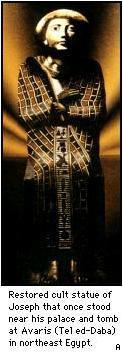
To truly understand the reasons for having any temple at Jerusalem, one really should begin with the Exodus of the Israelites from Egypt. This has now been firmly established as having taken place in the year 1447 NC; in the reign of Dudimose; the last Pharaoh of the 13th. Dynasty, (1448-1440 NC). (See Appendix C) Hitherto, Ramesses II had always been held responsible for cruelty to the Jews during the Oppression or Bondage and which ended with the Exodus. Whereas in fact he was of the 19th. Dynasty and reigned nearly 500 years later. There will be more about him further on.
Up until the time of the Exodus, the Israelites had lived and worked in Egypt for almost 215 years (1). Joseph (Yoséf) was, in fact, the first to lead his people from Canaan to Egypt, albeit unintentionally. This arose because seven of his brothers, jealous of his obvious high intelligence, had kidnapped him, thrown him into a well, and were contemplating the means of his death, when a passing caravan of Midianites presented a more convenient solution. Instead, therefore, Joseph was sold to them, and the Midianites in turn sold him as a bonded slave to Potiphar, head of the Royal Guard at Memphis. This was in 1683 NC and Joseph was barely seventeen years old.
After a while, his new situation attracted the amorous attentions of Potiphar's wife, but Joseph would have none of them. Consequently, he was imprisoned on the false charge of sexual harassment. Whilst in prison, he befriended two former courtiers and, through them, acquired a reputation for accurate interpretations of dreams.
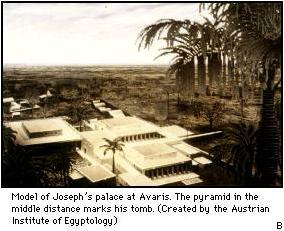
Upon his release, one of these courtiers later told Pharaoh Amenemhat III, Pharaoh of Upper and Lower Egypt. The king became curious, as he himself had been bedevilled by the recurring dreams of seven lean cows eating seven fat cows. Joseph was brought before Pharaoh to give his interpretation. This amounted to a warning that Egypt would enjoy seven prosperous years but that this would be followed by seven years of famine. Joseph advised prudence and comprehensive planning. Pharaoh was so impressed that he promoted Joseph immediately to the post Vizier. So it was in 1670 NC, that Joseph became the most powerful man in the country, second only to Pharaoh himself. He was now aged thirty.
Eight years later, with the predicted famine having its effect, Joseph encouraged his father, Jacob (Ya'akóv), together with a large number of relatives and other Jews, to emigrate to Egypt from Canaan in order to enjoy the benefits of Joseph's husbandry, and to begin what became known as The Sojourn.
Jacob and many of his family and followers settled in the district of Goshen in northeast Egypt. Jacob himself built his home at Avaris. Some 17 years later, Jacob died and Joseph then had a palace constructed on top of the foundations of his father's former residence.
Joseph went on to serve 10 Pharaohs. Indeed, at one time he was the sole ruler of Egypt for six years (1625-1619 NC) until a new Pharaoh could be chosen. He was over 100 years old when he died and was buried within a mausoleum adjoining his palace.
PRELUDE TO THE EXODUS
Over the ensuing years the Jews were very successful; so much so that the Egyptians became nervous and jealous of their growth and influence (2). Eventually, Pharaoh Sobekhotep IV ordered that the Jews be taken into oppressive slavery and that their population be controlled by infanticide. Thus the last 70 years of The Sojourn came to be known as The Bondage.
Meanwhile, Moses [Moshé, 'drawn (from water)'] was born near Memphis in 1527 NC and subsequently enjoyed a royal upbringing. Indeed, he became ranked as a Prince of Egypt and a successful military commander. His successes were such that Pharaoh Ay became very jealous of him and his popularity. He, therefore, was forced to flee into exile in Saudi Arabia in 1493 NC where he married and stayed for the next 44 years. It was not until 1449 NC, and after a number of urgent appeals from the Jewish communities that prompted Moses to return to Egypt.
Moses, now 78 years old, tried to persuade the newly crowned King Dudimose to release the Israelites, but he was steadfastly refused. Despite warnings from Moses, the afflictions started in 1448 NC in the form of what have come to be known as the ten plagues; e.g. frogs, flies, locusts, etc. (3). The eighth and ninth occurred both together the same night. The first was an unprecedented violent hail storm, followed closely by a catastrophic earthquake. The Black Land (a name at that time given to the whole of the Nile Delta north from Memphis, i.e. 10 miles (16 km) south of Cairo) was devastated: houses, roads, canals, and even the largest temples were all wrecked.
Of all the tribulations that beset the populace, there now occurred an event which has so far defied any clear and rational explanation: all newly-born children began to die; not necessarily all at once, but patently over a short period. No mention has ever been made as to whether Jewish babies suffered the same fate; in all probability they did as even animals were similarly afflicted. There is no question but that this disaster did occur, for widespread and haphazardly filled death-pits of that period, with animals and humans mixed up together, have been unearthed relatively recently and identified as belonging to this episode. At all events, this tragedy proved too much for Dudimose, and he now acceded to Moses' demands. Before being allowed their freedom, however, the Jews were first obliged to carry out all these burials themselves.
Then, having been joined by a number of Asiatics, they abandoned their homes and evacuated their principal store cities of Avaris and Pithom, in the district of Goshen. So began their trek eastwards to Canaan. Other workers, mainly Asiatics, similarly seized this opportunity to flee southwards in terror and en masse to get away from the stricken land.
THE EXODUS
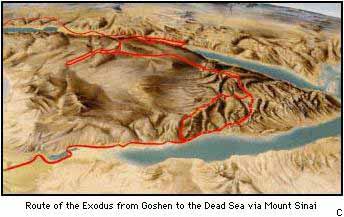
It is written that 600,000 men left (4). This is obviously a gross exaggeration as it would have meant a mass departure of well over 2 million people; far more than the population of the whole of Egypt in those days. (Even over 3200 years later, in 1800 AD, the population was only four million.) It is now thought that the Exodus, comprising the descendants of Benjamin, Jacob and Joseph, could not have been more than 150,000 all told, and probably a lot less. Even a multitude of this size surely must have posed enormous problems of logistics. In accordance with his written wishes before his death in circa 1600 NC, at the extraordinary age of 100+ years, Joseph's remains were removed from his tomb at Avaris and taken away by the Jews for eventual reburial in Canaan (5). It is generally believed that Joseph's final resting place is at 'Joseph's Tomb' in Shechem (now known as Nablus in the territory recently handed to the Palestinians).
Although the shortest route to Canaan lay eastwards along the Mediterranean coastline, it was well known that extensive military fortifications lay between the sea and the mountains to the north-west of the Sinai Peninsular. They existed to repel the marauding Philistines [Plishtím, 'invaders (from the sea)'] who occupied land extending north-eastward past what is now known as Gaza. In consequence, Moses had no choice but to head south-eastwards in order to follow the only alternative route which ran across the top and then down the eastern side of the Gulf of Suez. In those days, widespread reed marshes and salt pans lay between what is now Suez and the Bitter Lakes. The Hebrew word for 'Red Sea' is the same as the 'Sea of Reeds'. Incidentally, the reed subsequently became a unit of measurement. (See Appendix D)
The Jews had almost completed their crossing of the Sea of Reeds when Dudimose changed his mind as a consequence of political pressure for the return of the slaves. Thus he ordered units of his army, made up mainly of the newly evolved chariots, to re-arrest them. The story of the waters parting to allow the Jews passage is well known (6). The actual event, let alone its crossing place, nevertheless is so shrouded in tradition and legend that this cannot be confirmed. One needs to bear in mind that in those days it was Egyptian practice never to document failures of any kind; archivists and scribes were only prepared to record military victories and other notable achievements. However, if this particular account could be based on any substance, the actual crossing of this stretch of marshland might conceivably have been achieved during a period of neap tides at the head of the Gulf of Suez, coupled with strong northerly winds: whilst, on the other hand, it is equally possible that Pharaoh's pursuing forces might have suffered wholesale inundation from a combination of spring tides and severe southerly storms. The range of Spring tides at Suez is 8.0 feet (2.4 m) and Neap tides is 2.9 feet (0.9 m).
With his need to ensure an adequate water supply, Moses was obliged to follow the established road past the existing copper and turquoise mines that lay along the eastern side of the Red Sea. Eventually, he and his followers ended up camping for quite a time on the plain at the foot of Mount Horeb in Mount Sinai.
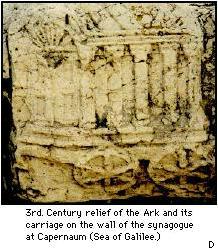
THE ARK OF THE COVENANT
By the time the bulk of the Jews had assembled at Mount Horeb, Moses was an old man in his 80's. It was here that he received the Ten Commandments. The account of him bringing these down Mount Sinai, in the form of two stone tablets, is certainly questionable, particularly as he is reported to have done so twice (7). It would seem more likely that he received the Commandments in inspirational form, and then had them set to stone once he had returned to his people. It is highly improbable that he could ever have twice carried down those heavy stone slabs from some way up a rocky 7000 feet (2150 m) mountain, let alone after 40 days without sustenance. Furthermore, the Apocrypha seems to confirm this, in that Moses was commanded "to write the Laws in the presence of the people of Israel." (8).
In due course, a special gold-encased Covenant Box of acacia wood, called the Ark, and supported by two long gold-encased wooden poles, was made in which to carry the now Sacred Tablets with their engravings. It was not large; it measured approximately 50 × 30 × 30 inches (1.20 × 0.75 × 0.75 m). Nevertheless, it would have been heavy enough with all its gold cladding and embellishments, besides containing the two Tablets and other sacred artefacts. (9).
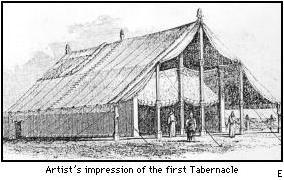
Although there appears to be no Biblical evidence to support this, it seems both logical and reasonable to assume that some time later the Ark, together with its adornments and carrying poles, was transported by means of a four-wheeled cart. Later accounts of the movement of the Ark, as reflected in both Books of Samuel, seem to imply this. The Ark itself was always kept carefully veiled whenever outside the large tented Tabernacle. The Tabernacle itself had been devised soon after the construction of the Ark, and was always erected whenever the Israelites were likely to remain static for any length of time.
In due course, the tribe of Levi was designated as the future source of hereditary priests appointed to guard the Ark.
WANDERING IN THE WILDERNESS
The Jews continued their wanderings in the wilderness in search of their Promised Land, and from whence their ancestors had originated some 220 years previously. The route of the Exodus is not known for certain and probably never will be. There were no maps in those days. Indeed, they would not be conceived until 580 BCE by Anaximander of Miletus in Greece, i.e. some 870 years later. Nowadays, Anaximander is generally recognised as having been the world's first cartographer. Consequently, scouting parties (spies) needed to be sent out to determine the best line of advance.
In the main, their travels took the Israelites up the east coast of Sinai. After a number of false trails, and with stops at times lasting several years, they eventually ended up along the eastern side of the Dead Sea (Salt Sea). So it was that, after 37 years and a journey of about 650 miles (1045 km), they reached Mount Nebo, adjacent to the northeast corner of the Dead Sea. Jericho was clearly visible on the other side of the river Jordan. It was here, in 1410 NC, that Moses is reported to have died, although his burial place has never been traced. If true, he would have been 117 years old!
THE PROMISED LAND
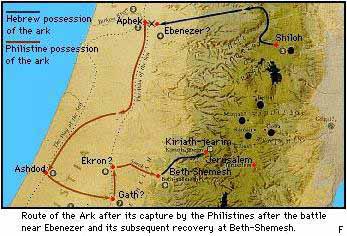
Joshua (Yehoshûa'), who had been the military commander for some years during the latter part of the Exodus, now took over from Moses. He led the Israelites to conquer Jericho. In fact he so destroyed both the city and its population that it remained abandoned for centuries thereafter. He then went on to conquer the whole of the hill country of Canaan as far as Hazor, five miles (8 km) north of the Sea of Galilee. On the way, he took Shechem and Shiloh. The hilltop town of Shiloh thereafter became the permanent resting place of the Ark and its Tabernacle for the next 400 years or so.
Following the death of Joshua, the tribes tended to fragment under their own separate leaders, who would come to be known as The Judges. Four tribes headed south-west, whilst the remaining eight spread over towards the coast and northwards to roughly level with Hazor. It was inevitable that they would all become involved in frequent and continuing skirmishes with various city-states or minor kingdoms in order to secure land for themselves. This turbulent state of affairs lasted until 1010 NC.
On one occasion, during the time of Samuel (Shmuél) who was the last of the great Judges, the Israelites were engaged in a fierce struggle against the Philistines around Ebenezer. Learning that the battle was going badly, Eli the High Priest ordered his two sons to take the Ark to the battle area to give heart to his countrymen. For all that, the battle was lost and both his sons were killed. The Ark was captured (10). Meanwhile Eli, who was a short plump man, had been sitting quietly on top of a stone wall awaiting the outcome when news of the defeat reached him. He was so shocked, he toppled backwards and broke his neck.
Somewhat surprisingly, after only seven months, the Philistines asked the Israelites to take back the Ark. It seemed that they had suffered from sudden and widespread sickness which they attributed to its unlawful possession. The Ark was hastily recovered and brought on a makeshift wagon to Kiriath, eight miles (13 km) west of Jerusalem where it was again rehoused in its former Tabernacle (11).
A YEARNING FOR UNITY
By this time almost all the Israelite tribes yearned for the peace and stability that they believed could come with re-unification. Accordingly, they appealed to Samuel to select a leader whom they could call King 'like the other nations'. He chose and anointed one Labayu who, after his death, came to be known as Saul [Shaûl, 'asked for (by the people)']. His people always referred to him as 'Great Lion of G-d'. (See Appendix E)
King Saul spent most of his reign fighting the hill tribes and Philistines. A rebel chieftain, called David, became prominent with his large contingent of Hebrew mercenaries who owed allegiance to no particular tribe. David himself was of the tribe of Judah having been born of humble origins in Bethlehem. Eventually, Saul put David to flight and the latter sought refuge in the kingdom Philistia.
As a revenge on Saul, David offered his force to the Philistines whom he knew were about to mount their own attack on Saul, but his gesture was refused as the Philistines did not altogether trust him. The eventual outcome was that, in Saul's final clash with the Philistines on Mount Gilboa, he was betrayed by a section of his own troops which resulted in his total defeat. Three of Saul's sons, including Jonathan, were killed and Saul himself committed suicide. The four bodies were decapitated and their heads suspended from the walls of the nearby city of Beth Shean (Beit Sheh-áhn).
Meanwhile, David had moved in and taken control as king of the city-state of Hebron, where some time previously he had married Saul's daughter, Michal. Saul's remaining son, Ishbaal, now inherited the kingdom but he reigned very ineffectually for only seven years before contracting an illness from which he died. Whereupon, David promptly exploited his position as Saul's son-in-law and assumed the kingship of the whole of Israel.
JERUSALEM — THE FIRST CAPITAL
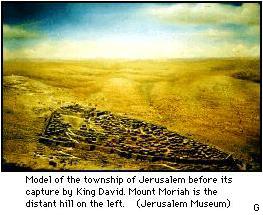
For most of his reign, David was obliged to conduct many bloody but, in the main, skilful campaigns to establish full sovereignty thereby to foster the unity of his people within a stable and wealthy economy. It was, therefore, not until much later in his life that he resolved to build a permanent temple — 'A House for G-d' — within which to retain the Ark. One is led to suppose that, in size, the proposed temple was to take the form more of a Royal chapel than a full scale temple in the accepted sense; nevertheless, David's aim was to make it the centrepiece of his proposed seat of government, as well as the religious focus of the Jewish nation. Hitherto, there had been no co-ordination of the country's administrative affairs, except in military matters. David was resolved to put this right.
As a first step, David seized the small township of Jerusalem (its ancient name was Shalem) with the intention of creating his country's capital. He did this for two reasons: first, for the political reason that Jerusalem was located close to the territorial division between the tribes of Judah and Israel; second, because he was attracted to the unusually conical shape of one of the three hills lying just north of the township. Later it came to be known as Mount Moriah, with Mount Zion to the west and Mount of Olives to the east. Another advantage was that Mount Moriah had its own ample water supply which was derived from streams coursing down the Kidron and Tyropoeon Valleys, and which already contributed to a small reservoir in Old Jerusalem, known as the Siloam Pool.
David's idea was to create a centre of government which was to include a Judgement or Mercy Seat (or throne), a Treasury (later known as the House of the Forest of Lebanon), Law Courts, quarters for priests, administrators, scribes, guards, servants, storage, archives and, of course, the royal apartments. Finally, the whole complex was to be enclosed within a fortified citadel on top of the mount which, if need be, could be capable of prolonged defence. The ultimate aim was to develop and convert the township of Jerusalem into a walled city embracing that citadel.
THE CONCEPT OF THE TEMPLE
With the purpose of securing a suitable site on the Mount Moriah, David bought an existing threshing field from a local farmer for 50 Shekels of silver (just under one pound (0.45 kg) in weight). In those days threshing fields tended to be sited on top of hills to catch the breeze in order to blow away the chaff.
After having been safeguarded for the previous 20 years in its tented Tabernacle at Kiriath, David, as a first step, decided to move the Ark temporarily up to Mount Zion. Thereafter, Jerusalem became known as the City of David.
In order to determine the available labour force, David ordered his army to carry out the first-ever population census. His troops did this by concentrating the citizens into compact districts for the purpose of rapid numbering (12). Unfortunately, due to the consequential lack of hygiene and sanitation from severe overcrowding, there arose widespread discontent, disease and bloodshed, resulting in the loss of about 20,000 lives.
To ameliorate the effects of this epidemic, David decided to make a sacrifice on mount Moriah (13). This was his first religious act there. He was then obliged to restart the census under more tolerable conditions. It disclosed that there were 153,300 foreign workers upon which he could draw.
Although the First Temple at Jerusalem has always borne King Solomon's name, it was really his father, David, who conceived the idea and who became the moving force. For instance, it was he who defined the general layout and planned all the logistic complexities that led to its eventual construction. Nor did David's vision stop there. He also specified in considerable detail the attendant buildings, including palaces for himself and his wife.
THE SELECTION OF SOLOMON
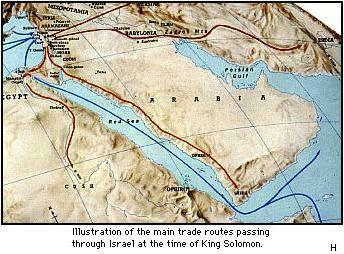
When nearly 70 years old, David had been reflecting upon his successor. He had discounted the suitability of his elder sons, Amnon and Adonijah, on account of their 'misdemeanours and treachery' (Chileab and Absalom were already dead). Instead, he decided to enthrone his youngest son, Solomon (Shlomó), just before he died (14). Whilst on his deathbed, David extracted an undertaking from Solomon that he would preserve the former's vision of a new Jerusalem and that it would be completed unaltered (15). It was around this time that Solomon married the daughter of King Haremheb, the reigning pharaoh of Egypt who also presented Solomon with a dowry of the city-state of Gezer which the former had recently subjugated.
The choice of Solomon was a wise one. Besides being aesthetically gifted, he was without doubt a most able administrator and adroit diplomat. Having inherited his father's vast wealth, he cleverly exploited the trade routes which passed through his country between India, Persia, Arabia and Babylonia (Iraq) on the one hand, and Egypt, Athens, Rome and Carthage (Tunisia) on the other. It seems to be generally agreed that his annual personal income was about 23 tons (23.4 tonnes) of pure gold, i.e. worth about £317M (~US$515M) at 2011 values (16).
He wasted little time initiating work on his father's grand design. He organised the labour force with attendant accommodation; opened up stone quarries; constructed special port facilities at Joppa (Jaffa/Tel Aviv) to handle the timber imports from Tyre; laid 50 miles (80 km) of new road from Joppa up to Jerusalem and excavated extensive water systems within Mount Moriah.
Originally the top of the Mount had been nearly 2500 feet (760 m) above sea level, although it stood only about 400 feet (120 m) above Jerusalem itself. Its sides sloped by as much as 45 degrees. During the course of site preparation, however, the hilltop was sliced off to provide a level platform on which to build the Temple. As a result the final height was reduced to 2420 feet (740 m) above sea level. When this was done, very large foundation stones are reported to have been sunk into the platform to a considerable depth. The whole of this preliminary work took four years before any start could be made on the Temple itself. Another three years and four months were needed to complete the project (17).
Solomon, King of Israel, is known as "the wisest of all men."1 The Bible (1 Kings 5:9-142) relates:
"9 And G-d gave Solomon wisdom and understanding exceeding much, and largeness of heart, even as the sand that is on the sea-shore. 10 And Solomon's wisdom excelled the wisdom of all the children of the east, and all the wisdom of Egypt. 11 For he was wiser than all men: than Ethan the Ezrahite, and Heman, and Calcol, and Darda, the sons of Mahol; and his fame was in all the nations round about. 12 And he spoke three thousand proverbs; and his songs were a thousand and five. 13 And he spoke of trees, from the cedar that is in Lebanon even unto the hyssop that springeth out of the wall; he spoke also of beasts, and of fowl, and of creeping things, and of fishes. 14 And there came of all peoples to hear the wisdom of Solomon, from all kings of the earth, who had heard of his wisdom."
1. Talmud, Eruvin, 21b.
2. A Hebrew-English Bible - According to the Masoretic Text and the JPS (Jewish Publication Society) 1917 Edition, Mechon Mamre, 2005, <www.mechon-mamre.org>.
It might now perhaps be easier if one follows chronologically the sequence of events that led to the construction and fate of the First and Second Temples.
Copyright © 1997- Freemasonry in Israel. All rights reserved. • Valid XHTML, CSS, WAI, Unicode.
Reproduction, distribution, or publication of any part of this web site, in any form or by any means, constitute infringement of copyright laws.
This web site is NOT the official site, statement, or opinion of any Grand Lodge, Lodge, or individual. All contributions are voluntary and represent only good intention and effort.